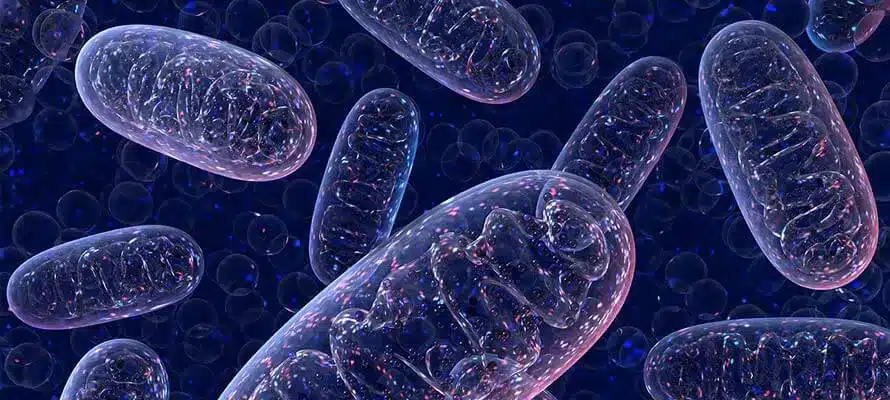What are Mitochondria?
Mitochondria are essentially your cell batteries. They churn out chemical energy-producing ATP called, adenosine triphosphate. The health of your mitochondria matters to every single cell in your body, except red blood cells, which do not have mitochondria, according to the IUBMB Life Journal [1].
These tiny factories in your cells turn the food you eat and the oxygen you breathe into energy. This energy powers all of your major organs.
The number of mitochondria inside a cell varies depending on the function of the cell. Each of your cells contains anywhere from 1000 to 2500 mitochondria. What a mind-blowing concept.
If you are looking to optimize both quality and longevity of life, protecting your mitochondrial function is vital.
Why Do Your Cell-Batteries Matter?
These tiny productive cell batteries are essential for energy, focus, vitality, and metabolism. The healthier your mitochondria the better you’ll feel. And who doesn’t want that?
When intracellular communication between mitochondria is heightened aging slows[2]. Your health and vitality improve.
Here’s more exciting news – caring for your mitochondria reduces nearly all age-related illnesses like Alzheimer’s and heart disease.
Let’s take a closer look at how you can significantly optimize your Mitochondria.
7 Ways To Maximize Mitochondrial Function:
- Ketosis
- Intermittent Fasting
- Micronutrients
- Sleep
- Strength Training
- Massage Therapy
- Diet Diversity
1. Ketosis
Your body can burn either ketones or glucose for energy. The ketogenic or “keto diet” can be an excellent choice to move your body into what is known as ketosis. Keto is a way to eat a high healthy-fat and a low carbohydrate diet.
You will begin to burn fat (called ketones), for fuel. Being in ketosis raises the levels of antioxidants in your mitochondria.
You will obtain satisfaction from eating healthy fats and high-quality proteins. No sugar or grains are allowed as these burn as “dirty” glucose.
Your body excels when you go from burning glucose to burning ketones. Research shows that the ketogenic diet can slow the progression of mitochondrial disease. It positively influences longevity pathways for healthy cell life.
The ketogenic diet benefits your mitochondria by burning a satiating clean form of fuel. Benefits may include: weight loss, reduced inflammation, increase mental cognition, clarity, and concentration. Being in ketosis can provide you with greater energy, slow aging, keep you full longer, and reduce the risk of chronic disease.
Ketosis provides a powerful way for you to gain mitochondria vitality.
SEE ALSO – Do Keto Supplements Help Increase Ketosis and Aid the Ketogenic Diet?
2. Intermittent Fasting
Fasting is an ancient, inexpensive, and truly powerful healing strategy. Similar to the keto diet, doing an extended fast utilizes ketones rather than glucose. When your body is in ketosis it has a long burning, clean source of energy for fuel.
Ketogenesis increases ketones in your bloodstream. The increase of ketones in your bloodstream initiates cellular signaling pathways known to influence vibrant health and slow aging.
Intermittent fasting encourages biogenesis in mitochondria[3], which prompts the process of the removal or repair of damaged[4] molecules.
Fasting improves mitochondrial function by reducing oxidative stress by-products. This increases oxygen efficiency inside your cell. Intermittent fasting may be done in tandem with eating a ketogenic diet.
Applying intermittent fasting into your busy lifestyle is easier than you might think. Begin by having your last meal at 6:00 pm. If you go from 6:00 pm to 6:00 am you’ve fasted 12 hours. Now, if you can stretch your fasting plan out to 16 hours this will benefit your mitochondria mightily.
Intermittent fasting costs nothing to implement and could transform the health of every cell in your body! Your mitochondria will thank you.
3. Micronutrients
Vitamins and minerals are micronutrients. Research suggests that virtually all adults are deficient in one or more important nutrients. Your mitochondria are especially susceptible to nutrient deficiencies[5].
The biochemist Bruce Ames, PhD., a professor emeritus at the University of California, Berkeley, and senior scientist at Children’s Hospital Oakland Research Institute, found that certain supplements reverse mitochondrial decay. He has the lofty goal of reversing and halting cognitive neurologic decline brought on by aging.
Here is a list of micronutrients that can assist you in gaining optimal mitochondria health, recommended by Dr. Joseph Pizzorno, ND.
- CoQ10
- A-lipoic acid
- Acetyl-l-carnitine
- Resveratrol
- NAC
- Vitamin E
4. Sleep
We used to believe sleep was a mystery, an untouchable unknown. Today, we realize how essential a good night’s sleep is for your brain’s mitochondria.
While you sleep your brain and body are very busy. During deep sleep, your skin repairs itself, your organs detox, and your kidneys clean your blood. You also replace cells, heal wounds, and build muscle. Your body recharges for the next day.
Evidence has been mounting that one of the major functions of sleep is to clear out metabolic waste. Researchers from Boston University have discovered that toxic leftovers are flushed out in waves by cerebrospinal fluid. This takes place during the slow-wave sleep phase.
While you sleep your brain rids itself of toxins harmful to your mitochondria. It is an amazing and efficient clean-up cycle. Bottom line, get your sleep!
5. Strength Training
Your mitochondria are profoundly affected by exercise. An article in Runner’s World said, “How much you train determines how much mitochondria your cells will contain, and how intensely you train determines how powerful each unit of mitochondria is.”
Be aware that encouraging your body to create new mitochondria requires a positive stressor – like a workout. Strength training can increase ATP production. ATP is one of the major players when it comes to driving the transfer of chemical energy.
Interestingly, the density and vitality of the mitochondria in your organs and muscles reveal much of your current level of health. For example, muscle contains scores more mitochondria than fat and a healthy heart is likely to be denser with mitochondria versus an unhealthy heart.
It should be rather obvious that you’ve got to get up and move your body. Increasing your physical activity by adopting active lifestyle[6] habits categorically reduces the rate of mitochondrial decline and attenuate age-related disease.
6. Massage Therapy
A study from the group Science Transitional Medicine on PubMed found, “When administered to skeletal muscle that has been acutely damaged through exercise, massage therapy[7]appears to be clinically beneficial by reducing inflammation and promoting mitochondrial biogenesis.” This means that massage generated new beneficial mitochondria.
If possible, be sure to schedule a massage into your weekly or bi-weekly routine. Your mitochondria will surely benefit.
7. Diet Diversity
Research notes that the diversity of the food in your diet matters profusely. Food diversity is protective, essential to your mitochondria. Eating a wide variety of nutrient-dense food gives you the ability to change the energy potential of every single cell in your body.
During my recent attendance at the 2020 NTA Conference, keynote speaker Dr. Terry Wahls said, “That eating for your mitochondria is almost always guaranteed to pay off. I am the canary in the coal mine, here as a warning to all of you. If you don’t care for your mitochondria, you will pay a very high price when it comes to your health.”
Recently, I’ve challenged some of my family and friends to a diet diversity contest. You might want to join us!
Here are a few ideas to challenge diet diversity with the people that you love.
- Make a two-week game to see who can eat the most diverse diet. Everyone keeps track of the foods they’ve eaten and a grand prize is given at the end of the two weeks.
- Have a dinner party theme with unfamiliar food culture. Cook the new interesting cuisine of that culture for your friends.
- Look for as many varieties of the same food and eat each variety. Examples: green tea or chamomile tea. Green apples or honey crisp apples. Duck or chicken.
- Replace your regular ingredients with healthier alternatives. For example, wheat flour to almond flour or soda to Kombucha.
- When you are at the grocery store, be aware to choose new and interesting foods that you’ve never chosen before.
- Use new organic spices and herbs, adding them generously into your meals.
- Treat yourself to a new cookbook and intentionally make all kinds of foods you’ve never considered.
Final Thoughts
Most of us desire to live a long, healthy life, free of debilitating disease. The goal is not to live forever, but to live well while aging. Taking care of your mitochondria does matter. Doing so will increase the chance of you staying fit and vital well into your golden years.
Consider implementing these seven easy steps into your wellness routine. Cheers to your good health and long life!
7 sources
Health Insiders relies on peer-reviewed studies, academic research institutions, and medical associations. We avoid using tertiary references. You can learn more about how we ensure our content is accurate and current by reading our editorial policy.
[1] Zhang ZW, Cheng J, Xu F, Chen YE, Du JB, Yuan M, Zhu F, Xu XC, Yuan S. Red blood cell extrudes nucleus and mitochondria against oxidative stress. IUBMB Life. 2011 Jul;63(7):560-5. doi: 10.1002/iub.490. PMID: 21698761.
[2] Sun N, Youle RJ, Finkel T. The Mitochondrial Basis of Aging. Mol Cell. 2016 Mar 3;61(5):654-666. doi: 10.1016/j.molcel.2016.01.028. PMID: 26942670; PMCID: PMC4779179.
[3] Jornayvaz FR, Shulman GI. Regulation of mitochondrial biogenesis. Essays Biochem. 2010;47:69-84. doi:10.1042/bse0470069
[4] Research on intermittent fasting shows health benefits
[5] Pizzorno J. Mitochondria-Fundamental to Life and Health. Integr Med (Encinitas). 2014;13(2):8-15.
[6] Onyango IG, Dennis J, Khan SM. Mitochondrial Dysfunction in Alzheimer's Disease and the Rationale for Bioenergetics Based Therapies. Aging Dis. 2016;7(2):201-214. Published 2016 Mar 15. doi:10.14336/AD.2015.1007
[7] Crane JD, Ogborn DI, Cupido C, Melov S, Hubbard A, Bourgeois JM, Tarnopolsky MA. Massage therapy attenuates inflammatory signaling after exercise-induced muscle damage. Sci Transl Med. 2012 Feb 1;4(119):119ra13. doi: 10.1126/scitranslmed.3002882. PMID: 22301554.






 This article changed my life!
This article changed my life!
 This article was informative.
This article was informative.
 I have a medical question.
I have a medical question.
 Ask a Question
Ask a Question

 This article contains incorrect information.
This article contains incorrect information.
 This article doesn’t have the information I’m looking for.
This article doesn’t have the information I’m looking for.